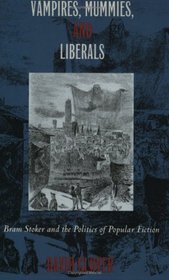Search -
Vampires, Mummies and Liberals: Bram Stoker and the Politics of Popular Fiction
Vampires Mummies and Liberals Bram Stoker and the Politics of Popular Fiction
Author:
Nearly a hundred years after its debut in 1897, Dracula is still one of the most popular of all Gothic narratives, always in print and continually adapted for stage and screen. Paradoxically, David Glover suggests, this very success has obscured the historical conditions and authorial circumstances of the novel’s production. By way ... more »
Author:
Nearly a hundred years after its debut in 1897, Dracula is still one of the most popular of all Gothic narratives, always in print and continually adapted for stage and screen. Paradoxically, David Glover suggests, this very success has obscured the historical conditions and authorial circumstances of the novel’s production. By way ... more »
ISBN-13: 9780822317982
ISBN-10: 0822317982
Publication Date: 12/1996
Pages: 232
Rating: ?
ISBN-10: 0822317982
Publication Date: 12/1996
Pages: 232
Rating: ?
0 stars, based on 0 rating
Publisher: Duke University Press
Book Type: Paperback
Other Versions: Hardcover
Members Wishing: 0
Reviews: Amazon | Write a Review
Book Type: Paperback
Other Versions: Hardcover
Members Wishing: 0
Reviews: Amazon | Write a Review
Genres:
- Literature & Fiction >> General >> Contemporary
- Horror >> United States
- Horror >> British & Irish
- Horror >> Reference
- Horror >> Vampires
- Literature & Fiction >> World Literature >> United States >> Classics >> General
- Literature & Fiction >> British & Irish >> 19th Century
- Literature & Fiction >> British & Irish >> General




